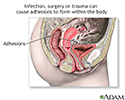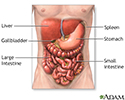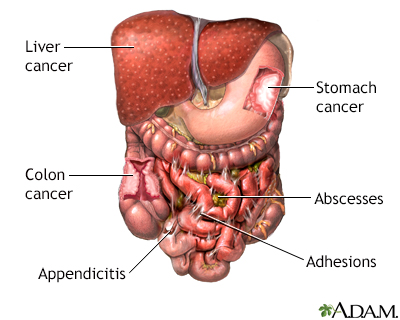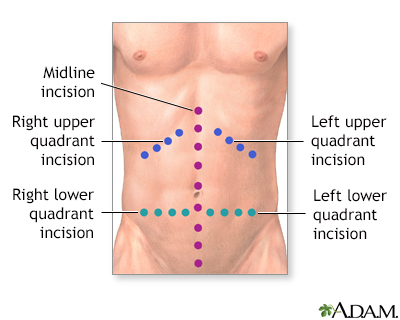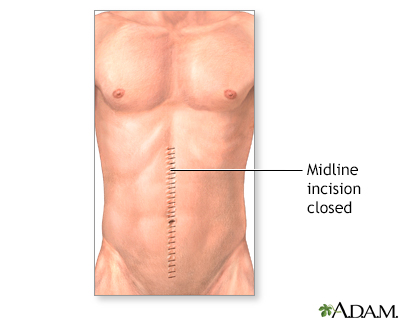Abdominal exploration
Exploratory surgery; Laparotomy; Exploratory laparotomyAbdominal exploration is surgery to look at the organs and structures in your belly area (abdomen). This includes your:
- Appendix
- Bladder
- Gallbladder
- Intestines
- Kidney and ureters
- Liver
- Pancreas
- Spleen
- Stomach
- Uterus, fallopian tubes, and ovaries (in women)
Surgery that opens the abdomen is called a laparotomy.
Description
Exploratory laparotomy is done while you are under general anesthesia. This means you are asleep and feel no pain.
Your surgeon makes a cut into the abdomen and examines the abdominal organs. The size and location of the surgical cut depend on the specific health concern.
A biopsy can be taken during the procedure.
Biopsy
A biopsy is the removal of a small piece of tissue for lab examination.

Laparoscopy describes a procedure that is performed with a tiny camera placed inside the abdomen. If possible, laparoscopy will be done instead of laparotomy.
Laparoscopy
Diagnostic laparoscopy is a procedure that allows your health care provider to look directly at the contents of the abdomen or pelvis.

Why the Procedure Is Performed
Your health care provider may recommend a laparotomy if imaging tests of the abdomen, such as x-rays and CT scans, have not provided an accurate diagnosis.
x-rays
X-rays are a type of electromagnetic radiation, just like visible light. An x-ray machine sends individual x-ray waves through the body. The images...

CT scans
A computed tomography (CT) scan is an imaging method that uses x-rays to create pictures of cross-sections of the body. Related tests include:Abdomin...

Exploratory laparotomy may be used to help diagnose and treat many health conditions, including:
- Cancer of the ovary, colon, pancreas, liver
Cancer
Cancer is the uncontrolled growth of abnormal cells in the body. Cancerous cells are also called malignant cells.
Read Article Now Book Mark Article - Endometriosis
Endometriosis
Endometriosis occurs when cells from the lining of your womb (uterus) grow in other areas of your body. This can cause pain, heavy vaginal bleeding,...
 ImageRead Article Now Book Mark Article
ImageRead Article Now Book Mark Article - Gallstones
Gallstones
Gallstones are hard deposits that form inside the gallbladder. These may be as small as a grain of sand or as large as a golf ball.
 ImageRead Article Now Book Mark Article
ImageRead Article Now Book Mark Article - Hole in the intestine (intestinal perforation)
- Acute appendicitis
Acute appendicitis
Appendicitis is a condition in which your appendix gets inflamed. The appendix is a small pouch attached to the end of the large intestine.
 ImageRead Article Now Book Mark Article
ImageRead Article Now Book Mark Article - Diverticulitis
Diverticulitis
Diverticula are small, bulging sacs or pouches that form on the inner wall of the intestine. Diverticulitis occurs when these pouches become inflame...
 ImageRead Article Now Book Mark Article
ImageRead Article Now Book Mark Article - Acute or chronic pancreatitis
Acute
Acute pancreatitis is sudden swelling and inflammation of the pancreas.
 ImageRead Article Now Book Mark Article
ImageRead Article Now Book Mark ArticleChronic pancreatitis
Pancreatitis is swelling of the pancreas. Chronic pancreatitis is present when this problem does not heal or recurs and does not improve, gets worse...
 ImageRead Article Now Book Mark Article
ImageRead Article Now Book Mark Article - Liver abscess
Liver abscess
Pyogenic liver abscess is a pus-filled pocket of fluid within the liver. Pyogenic means with pus.
 ImageRead Article Now Book Mark Article
ImageRead Article Now Book Mark Article - Pockets of infection (retroperitoneal abscess, abdominal abscess, pelvic abscess)
Abdominal abscess
An abdominal abscess is a pocket of infected fluid and pus located inside the belly (abdominal cavity). This type of abscess can be located near or ...
 ImageRead Article Now Book Mark Article
ImageRead Article Now Book Mark Article - Pregnancy outside of the uterus (ectopic pregnancy)
Ectopic pregnancy
An ectopic pregnancy is a pregnancy that occurs outside the womb (uterus).
 ImageRead Article Now Book Mark Article
ImageRead Article Now Book Mark Article - Scar tissue in the abdomen (adhesions)
Adhesions
Adhesions are bands of scar-like tissue that form between two surfaces inside the body and cause them to stick together.
 ImageRead Article Now Book Mark Article
ImageRead Article Now Book Mark Article
Risks
Risks of anesthesia and surgery in general include:
- Reactions to medicines
- Breathing problems
- Bleeding, blood clots, infection
Risks of this surgery include:
- Incisional hernia
Hernia
A hernia is a sac formed by the lining of the abdominal cavity (peritoneum). The sac comes through a hole or weak area in the strong layer of the be...
 ImageRead Article Now Book Mark Article
ImageRead Article Now Book Mark Article - Damage to organs in the abdomen
Before the Procedure
You will visit with your provider and have medical tests before your surgery. Your provider will:
- Do a complete physical exam.
- Make sure other medical conditions you may have, such as diabetes or high blood pressure, are under control.
High blood pressure
Blood pressure is a measurement of the force exerted against the walls of your arteries as your heart pumps blood to your body. Hypertension is the ...
 ImageRead Article Now Book Mark Article
ImageRead Article Now Book Mark Article - Perform tests to make sure that you will be able to tolerate the surgery.
- If you are a smoker, you should stop smoking several weeks before your surgery. Ask your provider for help.
Stop smoking
There are many ways to quit smoking. There are also resources to help you. Family members, friends, and co-workers may be supportive. But to be su...
 ImageRead Article Now Book Mark Article
ImageRead Article Now Book Mark Article
Tell your surgeon or nurse if:
- You are or could be pregnant
- You are taking any medicines, including drugs, supplements, or herbs you bought without a prescription
During the week before your surgery:
- You may be asked to temporarily stop taking medicines that keep your blood from clotting. These medicines are called blood thinners. This includes over-the-counter medicines and supplements such as aspirin, ibuprofen (Advil, Motrin), naproxen (Aleve, Naprosyn), and vitamin E. Many prescription medicines are also blood thinners.
- Ask your surgeon which medicines you should still take on the day of surgery.
On the day of surgery:
- Follow instructions about when to stop eating and drinking.
- Take the medicines your surgeon told you to take with a small sip of water.
- Arrive at the hospital on time.
Outlook (Prognosis)
You should be able to start eating and drinking normally about 2 to 3 days after the surgery. How long you stay in the hospital depends on the severity of the problem. Complete recovery usually takes about 4 to 6 weeks.
References
Landmann A, Bonds M, Postier R. Acute abdomen. In: Townsend CM Jr, Beauchamp RD, Evers BM, Mattox KL, eds. Sabiston Textbook of Surgery. 21st ed. St Louis, MO: Elsevier; 2022:chap 46.
Young S, Tsai S. Management of periampullary cancer. In: Cameron JL, Cameron AM, eds. Current Surgical Therapy. 14th ed. Philadelphia, PA: Elsevier; 2023:589-599.
Digestive system - illustration
The esophagus, stomach, large and small intestine, aided by the liver, gallbladder and pancreas convert the nutritive components of food into energy and break down the non-nutritive components into waste to be excreted.
Digestive system
illustration
Pelvic adhesions - illustration
Pelvic adhesions are bands of scar-like tissue that form between two surfaces inside the body. Inflammation from infection, surgery, or trauma can cause tissues to bond to other tissues or organs.
Pelvic adhesions
illustration
Abdominal exploration - series
Presentation
Digestive system - illustration
The esophagus, stomach, large and small intestine, aided by the liver, gallbladder and pancreas convert the nutritive components of food into energy and break down the non-nutritive components into waste to be excreted.
Digestive system
illustration
Pelvic adhesions - illustration
Pelvic adhesions are bands of scar-like tissue that form between two surfaces inside the body. Inflammation from infection, surgery, or trauma can cause tissues to bond to other tissues or organs.
Pelvic adhesions
illustration
Abdominal exploration - series
Presentation
Review Date: 3/31/2024
Reviewed By: Debra G. Wechter, MD, FACS, General Surgery Practice Specializing in Breast Cancer, Virginia Mason Medical Center, Seattle, WA. Also reviewed by David C. Dugdale, MD, Medical Director, Brenda Conaway, Editorial Director, and the A.D.A.M. Editorial team.


